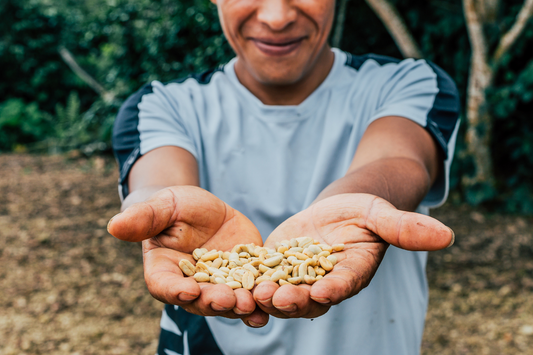
BLENDS VS SINGLE ORIGIN COFFEES
Share
WHICH COFFEE IS RIGHT FOR YOU?
Ever stood in front of a wall of coffee beans at your local café or grocery store and opted for the same old beans simply because you were overwhelmed with the variety of coffees available?
It's not your fault. Coffee roasters, baristas, and other industry professionals have made specialty coffee unnecessarily complicated for consumers, with jargon-heavy labeling, convoluted descriptions, and a lack of standardization between roast levels and tasting notes.
LETS EXPLORE THE JARGON
While details like altitude, processing methods, and farm origin hold immense value for coffee professionals, navigating this new vocabulary alongside a constantly expanding range of flavors can be a daunting task for consumers.
This first article in a 3-part series aims to demystify the process of choosing the perfect coffee for you. We'll start by tackling the basic distinction between Single-Origin Coffees and Blends:



Single-Origin Coffees
Last time you visited a specialty coffee shop, did you notice some of the coffees were labeled by country and region? A classic example is our Colombia, Eterna Primavera or our Mexico, Sierra Madre Chiapas. These coffees reference not only the general producing country, but also a particular district, department, neighboring town, or region where the coffee was grown. Simply put, single-origin coffee can be traced back to a certain farm, farmer, growing region, or crop.

High-quality, direct trade coffees are frequently single-origin, sometimes going even further to specify a single farm, estate, or microlot. in the case of microlots, the bean not only comes from a certain farm but is also a single (often rare) coffee varietal. For these coffees, it's commonplace to see the name of the farm or cooperative on the label:
"Franke Torres – Caturra, Huila, Colombia"
(Producer Name) - (Coffee Variety) - (Region) - (Country)
So, what does this mean for you?
If you're the adventurous type, looking to explore unconventional floral, fruity, spicy, or chocolatey notes, various types of acidity from malic to lactic and unique mouthfeels; drinking single-origin coffee is likely a good choice. These coffees are best enjoyed without any additives, require a little more effort to dial in, and tend to produce cleaner, more distinct cups, especially when paired with filter brewing methods.
Now Let's Talk About Blends

Blended coffees are exactly what the name suggests: a blend of multiple coffees spanning various origins, producers, varieties, and processing methods. Blends have a bad rap in the specialty coffee community, as traditionally roasters would use a "kitchen sink" approach to blending low-quality coffees and masking them with a more developed profile to cover up any tasting defects. In recent years, many specialty roasters, including ourselves, have revisited blending as a means to pair complementary flavors, create consistent year-round offerings, and more approachable coffees.
For example, a roaster may choose to match a dense, high-grown, bright, and washed African coffee with delicate notes of florals, tea, and citrus with an earthy, chocolatey, and sweet Indonesian to produce a more balanced and consistent profile.
If you are looking for a more a more familiar and balanced taste, often with notes of caramel, chocolate, nuts, with mild to moderate acidity, blends will be a better choice. Most roasters tend to develop their blends a little more and the darker roast profile, which offers the benefit of an easier to dial in coffee on espresso and on that pairs well with most milk options (if one chooses)
In the next article, we will discuss how climate, elevation, post harvest processing and varietal or cultivar interact to ultimately determine what flavours are present in each cherry seed.




